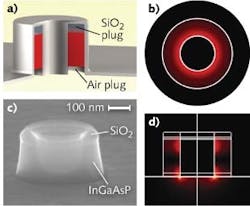
Researchers have unveiled the smallest room-temperature CW lasers operating at telecommunications wavelengths ever produced—and they operate with practically no lasing threshold. The work has implications for on-chip optical communication and, if integrated into silicon-compatible platforms, for far-wider implementation in telecommunications.
Experts at the University of California–San Diego (UCSD) set out to get closer to the “ultimate nanolaser”—scalable, low-threshold, efficient, room-temperature, and of course nanometer-scale. They argue that the best examples of nanolasers so far fall down principally on the matter of threshold.1
“For subwavelength cavities, the metal loss dominates other sources of loss, such as scattering that is by itself higher in smaller lasers due to higher surface-to-volume ratios,” says UCSD’s Mercedeh Khajavikhan. “As a result, the pump power required to achieve lasing typically becomes prohibitively high. Because of the high metal loss, most previous nanolaser designs use metals merely to confine light in structures essentially similar to the conventional nonsubwavelength lasers, avoiding the concentration of fields near the metal. Our goal was to implement a structure that provides a scalable approach to laser miniaturization.”
Khajavikhan explains that the UCSD group chose an approach different from any other demonstrated approaches for small lasers, using nanoscale coaxial-shaped cavities well known to electrical engineers and widely used as transmission lines in the microwave regime. What makes the coaxial cavities fit for the purpose is that such structures support a transverse electromagnetic mode no matter how small they get, which Khajavikhan says “makes them an ideal choice for deeply subwavelength lasers.”
The team fabricated a number of the 100 and 175 nm laser cavities, each of which had a metallic rod at its center surrounded by rings of air, indium gallium arsenide phosphide, and silica, with the whole assembly then coated with a silver/aluminum alloy. The air and silica “plugs” serve to enforce mode confinement. The lasers were then optically pumped using a commercial 1064 nm laser.
The nanoscale design achieves two things. The cavity quantum electrodynamic effects that come into play at those sizes coupled any spontaneous emission directly into the lasing mode. What’s more, the transverse electromagnetic mode that defined the lasing was nearly 15 times smaller than the wavelength of the emitted light.
The output modes at 1260 nm and 1590 nm were imaged, showing their TEM character, and the devices were shown to couple as much as 99% of spontaneous emission into the lasing mode.
The team is well aware of the many implications of such threshold-free lasers—so work is already underway to implement electrical rather than optical pumping. “Realizing the revolutionary potential of these devices, our ambition goes beyond achieving electrical pumping,” Khajavikhan says.
Applications that would follow include on-chip optical routing with significantly fewer limitations. “Because of their lack of threshold, these devices can be modulated rapidly, and thus can become a backbone for future telecommunication devices,” notes Khajavikhan.
The team also envisions an array of phase-controlled nanolasers arranged to form a microlaser whose beam can be arbitrarily shaped, or putting the lasers to use in high-throughput sensing and spectroscopy systems. Shaya Fainman, senior author of the paper, says, “We feel this is just a beginning of a new family of light emitters with superior characteristics, and many advances in this new area are yet to come.”
REFERENCE
1. M. Khajavikhan et al., Nature (2012); doi:10.1038/nature10840.